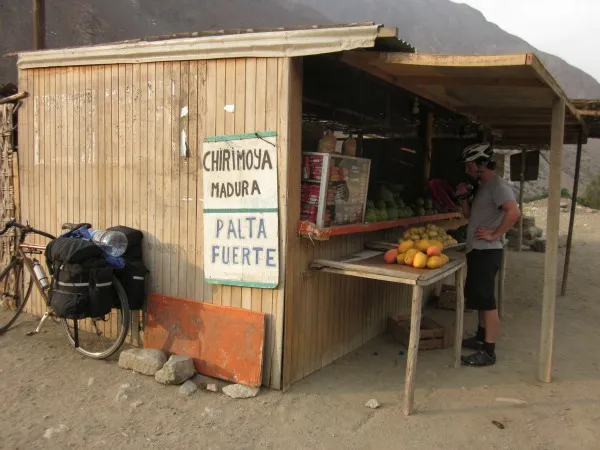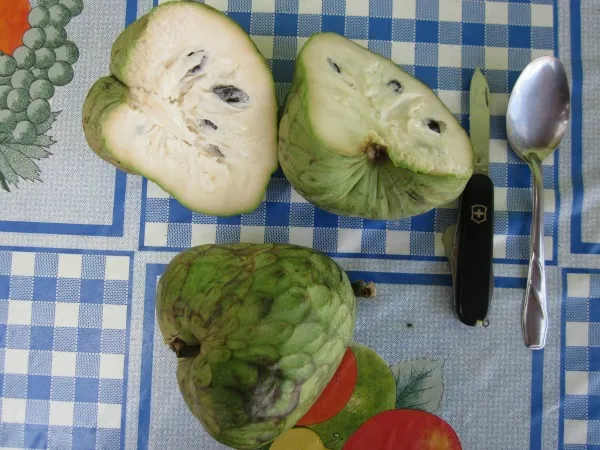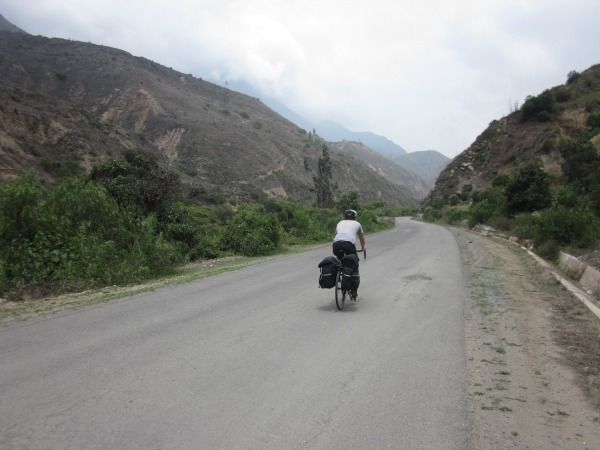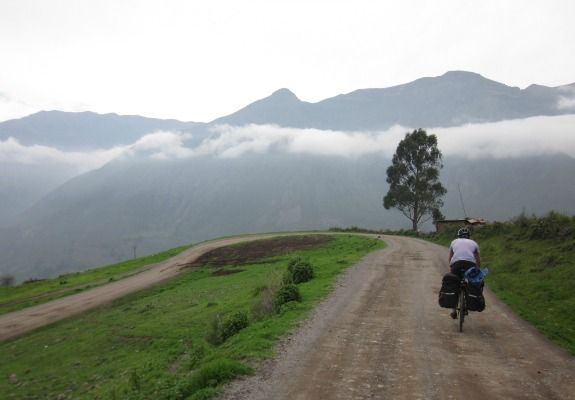From the Slums of Lima to the Peaks of the Andes
After unpacking and assembling his bicycle at the airport terminal, the author heads north on the Pan-American Highway toward the mountain town of Canta
/https://tf-cmsv2-smithsonianmag-media.s3.amazonaws.com/filer/20130107092132PeruSlumSMALL.jpg)
That there could be anything in the world but dust, rubble, traffic, burning trash heaps, mangy dogs and slums seemed impossible as we rolled northward through Lima. Andrew and I had just unpacked and assembled our bicycles in the airport terminal after 13 hours in the air. We were dehydrated, hungry, sleepy and, now, trying to steel ourselves against this grimy ugliness. We found a two-gallon jug of purified water at a gas station, the tap water being off-limits to foreigners preferring not to risk getting sick, and moved north along the Pan-American Highway. Through the polluted hazy air we saw the brown ghosts of mountain peaks towering just east of the city—the abrupt beginning to the Andes. But here, we were all but blinded by traffic, noise and ugliness. I assured myself that the city would soon give way to countryside—it always does, whether leaving Madrid, or Athens, or Milan, or Istanbul—but the sprawling slums seemed endless. Dust plumed into our faces, cars honked, dogs barked. We grew sticky and filthy with sweat, sunscreen and dirt. For several miles we followed a bicycle path—a heartening gesture by this monster of a city—but trash heaps blocked the way in places.
At some point we saw a patch of green grass. Later, we sat on a grassy road median to eat a cluster of bananas. I recall hearing a bird chirp farther down the road. A farm appeared, and trees. We both took notice at once of a soccer field in a green river valley. Trees by the road sagged with mangoes, while others were studded with ripening figs. We found ourselves riding side by side—for the traffic had thinned. The transition was complete. We were, finally, in the countryside, with Lima a horror we hoped not to see again soon. By evening we were crawling uphill, well on our way to a mountain town called Canta—though it was still a vertical mile above and 50 miles ahead. Near dusk, with fruit and canned tuna and wine for dinner, we rolled through the gate of a campground, called Sol de Santa Rosa. “Showers and bathrooms are back toward the orchard,” our host said in Spanish. “Camp anywhere you like on the green grass.”

Cherimoya season is on here in the mountains, true to our hopes. The big, green, heart-shaped, alligator-skinned creatures are heaped on tables at roadside fruit shacks, with painted signs telling passersby that the fruits are ripe. When Andrew and I first saw a sign reading “Chirimoya madura,” we pulled over in a hurry. Five soles per kilo, the man inside the shack told us. About $1 per pound. I told the vendor that this was very exciting for us, that cherimoyas are an exotic fruit in California, where most are imported and sold for at least $8 each. “Here,” the man said, “we are in the center of production.” We each bought a three-pounder for dinner, and that evening in camp sliced them in two. A ripe cherimoya is pliable, like a ripe avocado. Inside, the flesh is snow-white and studded with raisin-size black seeds. The flesh is intensely sweet, fibrous near the stem and otherwise seamless and creamy throughout. It tastes like pineapple, banana and bubble gum. Cherimoyas are native to the Andes, and the season here runs December through April. We’ve landed in a bed of roses.

We’ve also taken a liking to a new fruit called lucuma, a round, greenish-brown tree fruit with a smooth, plastic-like hide and starchy, sticky pumpkin-colored flesh, somewhat like a hard-boiled egg yolk. The fruit is a Peruvian specialty, made into sweets and ice cream and virtually unknown in America. Mangoes, too, are superb, here—with brilliant aroma and a fresh, tangy, concentrated flavor. We’ve found avocados cheap and abundant, and heaps of grapes, which we won’t touch, guessing they’ve been washed with local tap water. As we move through each small village, we ignore the smells of cooking meat and vegetables from restaurants, and we pass by the offers from sidewalk vendors selling tamales and hot drinks. One vendor sliced us a piece of cheese as we looked over his fruits—and we all but ran from the place. Ceviche, too, is another local food we won’t touch—not yet, anyway, as we’ve been advised repeatedly not to eat anything potentially contaminated by dirty water or sloppy handling. But the cherimoyas almost make up for our losses.
The season here has us confused. We are in the Southern Hemisphere by about ten degrees of latitude, and so we would expect this to be summer. But folks are telling us we have come in the winter, that July in the Andes is summer and that when it is summer on the coast it is winter in the mountains. We got hit by a thunderstorm as we crawled uphill toward Canta, and as we wrapped tarps around our bikes we saw that we may need to work out a better rain gear system. Locals say the rain is heavy this time of year. Dense fog enveloped us at about the 9,000 foot level as we crawled onward, and we are feeling the altitude—gasping to recover our breath each time we speak or have a drink of water. We have each taken a dose of altitude pills, and we hope not to get sick, as the only certain cure for altitude sickness is to turn around—and we don’t wish just yet to see Lima again.

We finally made our arrival in the much anticipated town of Canta, and to our alarm there is almost nothing here—nothing, after 80 miles of following road signs and mile markers and believing we were on our way to a mountain hub of activity and recreation and great outdoor markets and vegetarian yoga communes with food to share and Internet cafés and shops offering wireless 3G plans. Nothing, that is, except for fruit shacks, tamale vendors, a cheap hotel and the high Andes surrounding us. Now, considering the many dismal shades of Lima, nothing doesn’t seem bad at all.
Further Into the Andes
Ahead we see on our map Lago Junín, a large high-altitude mountain lake, the sizable towns of Cerro de Pasco and Huanaco and the great mountain pass of Ticlio, or Anticona.

Planning Your Next Trip?
Explore great travel deals
Smithsonian magazine participates in affiliate link advertising programs. If you purchase an item through these links, we receive a commission.
/https://tf-cmsv2-smithsonianmag-media.s3.amazonaws.com/accounts/headshot/Off-Road-alastair-bland-240.jpg)
/https://tf-cmsv2-smithsonianmag-media.s3.amazonaws.com/accounts/headshot/Off-Road-alastair-bland-240.jpg)